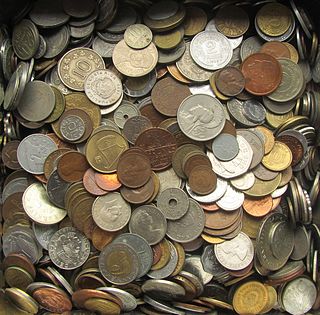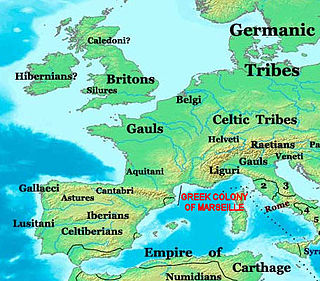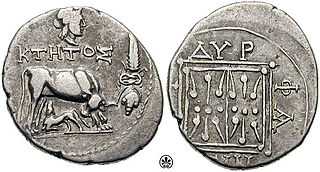
A coin is a small object, usually round and flat, used primarily as a medium of exchange or legal tender. They are standardized in weight, and produced in large quantities at a mint in order to facilitate trade. They are most often issued by a government. Coins often have images, numerals, or text on them. The faces of coins or medals are sometimes called the obverse and the reverse, referring to the front and back sides, respectively. The obverse of a coin is commonly called heads, because it often depicts the head of a prominent person, and the reverse is known as tails.

The denarius was the standard Roman silver coin from its introduction in the Second Punic War c. 211 BC to the reign of Gordian III, when it was gradually replaced by the antoninianus. It continued to be minted in very small quantities, likely for ceremonial purposes, until and through the Tetrarchy (293–313).

The as, occasionally assarius, was a bronze, and later copper, coin used during the Roman Republic and Roman Empire.

Roman currency for most of Roman history consisted of gold, silver, bronze, orichalcum and copper coinage. From its introduction during the Republic, in the third century BC, through Imperial times, Roman currency saw many changes in form, denomination, and composition. A feature was the inflationary debasement and replacement of coins over the centuries. Notable examples of this followed the reforms of Diocletian. This trend continued with Byzantine currency.
Roman Republican currency is the coinage struck by the various magistrates of the Roman Republic, to be used as legal tender. In modern times, the abbreviation RRC, "Roman Republican Coinage" originally the name of a reference work on the topic by Michael H. Crawford, has come to be used as an identifying tag for coins assigned a number in that work, such as RRC 367.

The Coinage of India began anywhere between early 1st millennium BCE to the 6th century BCE, and consisted mainly of copper and silver coins in its initial stage. The coins of this period were Karshapanas or Pana. A variety of earliest Indian coins, however, unlike those circulated in West Asia, were stamped bars of metal, suggesting that the innovation of stamped currency was added to a pre-existing form of token currency which had already been present in the Janapadas and Mahajanapada kingdoms of the Early historic India. The kingdoms that minted their own coins included Gandhara, Kuntala, Kuru, Magadha, Panchala, Shakya, Surasena, Surashtra and Vidarbha etc.

The stater was an ancient coin used in various regions of Greece. The term is also used for similar coins, imitating Greek staters, minted elsewhere in ancient Europe.

Addedomarus was a king of south-eastern Britain in the late 1st century BC. His name is known only from his inscribed coins, the distribution of which seem to indicate that he was the ruler of the Trinovantes.

Like the Egyptians, Phoenicians and Carthaginians, the Etruscans were rather slow to adopt the invention of coinage. The brief period of Etruscan coinage, with the predominance of marks of value, seems to be an amalgam that reconciles two very different monetary systems: the 'primitive' bronze-weighing and aes grave economy of central Italy with that of struck silver and gold issues of southern Italian Greek type not familiar in Etruria.
Damastion was an ancient city in the area of central Balkans, known for its silver coins dating back to the 4th century BC. It is attested only in Strabo who says that the city had silver-mines and locates it in Illyria. The ancient author reports that the city was under the authority of the Illyrian tribes of Dyestes and Enchelei-Sesarethii, and that Aegina colonized it. At 356–358 B.C. the mines came under the control of Macedon.

Celtic coinage was minted by the Celts from the late 4th century BC to the mid 1st century AD. Celtic coins were influenced by trade with and the supply of mercenaries to the Greeks, and initially copied Greek designs, especially Macedonian coins from the time of Philip II of Macedon and his son, Alexander the Great. Thus Greek motifs and even letters can be found on various Celtic coins, especially those of southern France.

The Greeks in pre-Roman Gaul have a significant history of settlement, trade, cultural influence, and armed conflict in the Celtic territory of Gaul, starting from the 6th century BC during the Greek Archaic period. Following the founding of the major trading post of Massalia in 600 BC by the Phocaeans at present day Marseille, Massalians had a complex history of interaction with peoples of the region. Large Greek colonies also existed west of the Rhône, particularly at Agde and Béziers, the latter of which both predates, and was larger than, the Marseille colony.
The coinage metals comprise those metallic chemical elements and alloys which have been used to mint coins. Historically, most coinage metals are from the three nonradioactive members of group 11 of the periodic table: copper, silver and gold. Copper is usually augmented with tin or other metals to form bronze. Gold, silver and bronze or copper were the principal coinage metals of the ancient world, the medieval period and into the late modern period when the diversity of coinage metals increased. Coins are often made from more than one metal, either using alloys, coatings (cladding/plating) or bimetallic configurations. While coins are primarily made from metal, some non-metallic materials have also been used.

Illyrian coinage which began in the 6th century BC continued up to the 1st century of Roman rule. It was the southern Illyrians who minted the first coins followed by the northern Illyrian during the Roman era. Illyrian coins have also been found in other areas apart from Illyria, such ancient Macedonia, Italy, Greece, Asia Minor and Egypt.
Philip de Jersey is a Guernsey archaeologist and numismatist. He is known as an expert on Celtic coins of the Iron Age.
Potin is a base metal alloy used in coins. It is typically a mixture of copper, tin and lead and does not typically contain significant precious metals. Potin is usually used in reference to Celtic coinage.
Carthaginian or Punic currency refers to the coins of ancient Carthage, a Phoenician city-state located near present-day Tunis, Tunisia. Between the late fifth century BC and its destruction in 146 BC, Carthage produced a wide range of coinage in gold, electrum, silver, billon, and bronze. The base denomination was the shekel, probably pronounced in Punic. Only a minority of Carthaginian coinage was produced or used in North Africa. Instead, the majority derive from Carthage's holdings in Sardinia and western Sicily.

The Celtic currency of Britain were the various items and coins used as currency between approximately 200 BC and AD 60. The earliest currency consisted of various forms of iron bars. Coins were first imported in large numbers in around 150 BC and domestic minting began around 100BC. Coin production was largely ended by the Roman conquest of Britain, first by the Claudian invasion of AD 43 and later by the Defeat of Boudica in AD 60 or 61. Cast coins may have been produced for a few more years around Hengistbury Head. Exact dating of coins often changes in the light of new research.
Esunertos, or Iisuniirtos, was a male ruler in Britain in the western Thames basin in the second half of the 1st century BC. He is known only from a few rare gold and silver coins, which provide the full spelling of his name – IISVNIIRTOS. This is also the first time that the Celtic nominative form -os- has been observed.












